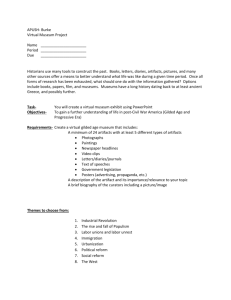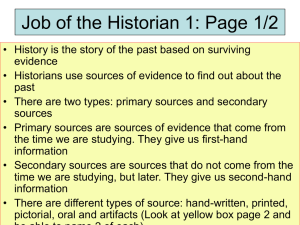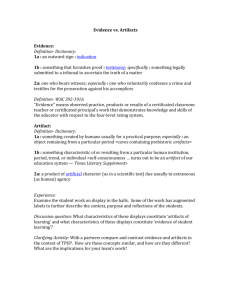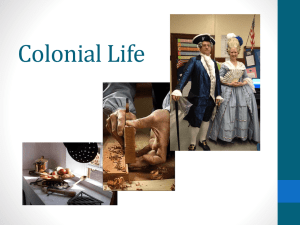Boom-Bust-Recovery:
advertisement
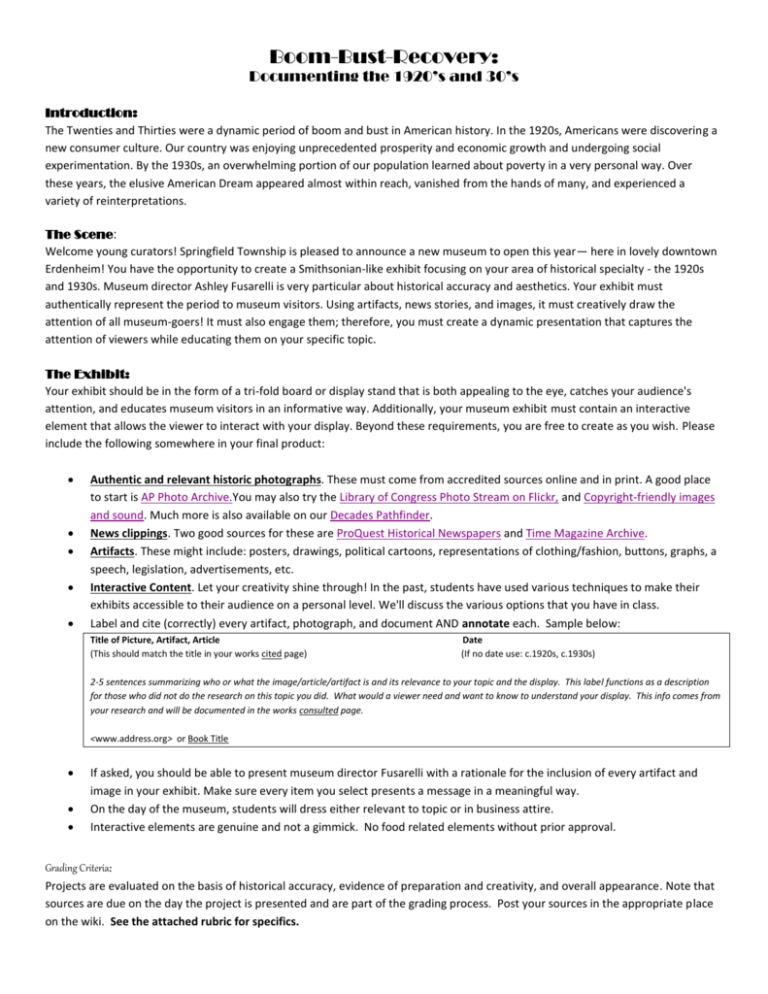
Boom-Bust-Recovery: Documenting the 1920’s and 30’s Introduction: The Twenties and Thirties were a dynamic period of boom and bust in American history. In the 1920s, Americans were discovering a new consumer culture. Our country was enjoying unprecedented prosperity and economic growth and undergoing social experimentation. By the 1930s, an overwhelming portion of our population learned about poverty in a very personal way. Over these years, the elusive American Dream appeared almost within reach, vanished from the hands of many, and experienced a variety of reinterpretations. The Scene: Welcome young curators! Springfield Township is pleased to announce a new museum to open this year— here in lovely downtown Erdenheim! You have the opportunity to create a Smithsonian-like exhibit focusing on your area of historical specialty - the 1920s and 1930s. Museum director Ashley Fusarelli is very particular about historical accuracy and aesthetics. Your exhibit must authentically represent the period to museum visitors. Using artifacts, news stories, and images, it must creatively draw the attention of all museum-goers! It must also engage them; therefore, you must create a dynamic presentation that captures the attention of viewers while educating them on your specific topic. The Exhibit: Your exhibit should be in the form of a tri-fold board or display stand that is both appealing to the eye, catches your audience's attention, and educates museum visitors in an informative way. Additionally, your museum exhibit must contain an interactive element that allows the viewer to interact with your display. Beyond these requirements, you are free to create as you wish. Please include the following somewhere in your final product: Authentic and relevant historic photographs. These must come from accredited sources online and in print. A good place to start is AP Photo Archive.You may also try the Library of Congress Photo Stream on Flickr, and Copyright-friendly images and sound. Much more is also available on our Decades Pathfinder. News clippings. Two good sources for these are ProQuest Historical Newspapers and Time Magazine Archive. Artifacts. These might include: posters, drawings, political cartoons, representations of clothing/fashion, buttons, graphs, a speech, legislation, advertisements, etc. Interactive Content. Let your creativity shine through! In the past, students have used various techniques to make their exhibits accessible to their audience on a personal level. We'll discuss the various options that you have in class. Label and cite (correctly) every artifact, photograph, and document AND annotate each. Sample below: Title of Picture, Artifact, Article (This should match the title in your works cited page) Date (If no date use: c.1920s, c.1930s) 2-5 sentences summarizing who or what the image/article/artifact is and its relevance to your topic and the display. This label functions as a description for those who did not do the research on this topic you did. What would a viewer need and want to know to understand your display. This info comes from your research and will be documented in the works consulted page. <www.address.org> or Book Title If asked, you should be able to present museum director Fusarelli with a rationale for the inclusion of every artifact and image in your exhibit. Make sure every item you select presents a message in a meaningful way. On the day of the museum, students will dress either relevant to topic or in business attire. Interactive elements are genuine and not a gimmick. No food related elements without prior approval. Grading Criteria: Projects are evaluated on the basis of historical accuracy, evidence of preparation and creativity, and overall appearance. Note that sources are due on the day the project is presented and are part of the grading process. Post your sources in the appropriate place on the wiki. See the attached rubric for specifics. The Process: Library Research Day 1: Use at least one book source and one internet source from the “Doing the Decades” collection to collect background information on your chosen topic. Type a detailed explanation (1-3 paragraphs) that summarizes the information and ideas you will need to portray in your display. This should include basic information like who or what the topic is about, when and where it was prominent, and why it is significant enough to be displayed. Formulate and propose a display theme - how will you present your display and what interactive elements you can include. Cite your book and internet sources on the same page. Library Research Day 2: Begin to use copyright-friendly image generators (AP Photo Archive, Wikimedia commons), to gather news, photos, and artifacts about your topic. Do not forget to document sources as you go. You should “inventory” each as you go along, so you track which requirements you are meeting. I will collect a copy of this inventory, with citations, at the end of the day. Be sure to save it so you can add to it with each library visit! Remember, you need 10 Historic Photos, 5 News Clippings, and 5 Artifacts! Library Research Day 3: Continue above…again, I will collect your expanded inventory list at the end of the day. Library Research Day 4: You should have collected all of your images at this point. Today should be used typing your labels for each. Include a citation, date, and annotation. If you did this as you completed your research, you should work on your interactive activity. (Suggestions: Crossword, comprehensive writing prompt, true-false questions, guided note-taking, timeline or scavenger hunt to be completed by viewing your display, and listening to your presentation, google doc survey/quiz, etc) Library Research Day 5: The library has been reserved but may not need to be used a 5 th day. Resources: Textbooks: A History of the US, The Americans, American Nation, America-Pathways Library Books: Biography Section, Reference Section, Art Section, History (970’s) Section Online Lessons: Ms Fusarelli’s 20s and 30s Museum Resource Link (25+ educational links)! Catalogs and Databases: ProQuest Historical Newspapers, Student Resource Center Gold, Literature Resource Center, Biography Resource Center, ABC-CLIO American History, AP Photo Archive, Beyond Books, Curriculum Resource Center, Wikimedia Commons STHS MLA Citation Guide & Noodletools 20’s and 30’s Project Topic List: The Communist Threat: Red Scare / Palmer Raids / Sacco & Vanzetti Nativism / Immigration Quotas / the New KKK The Red Summer: Race Relations Following World War I Politics: Presidential Administrations and Scandals A Modern Woman: Flappers / the 19th Amendment / Criticism African American Advancement: Harlem Renaissance / Marcus Garvey / UNIA & NAACP Entertainment: Vaudeville, Hollywood, Fads & Amusements The Jazz Age: It's History and Impact on the Cultural Landscape & its influence on multiple art forms Art & Architecture: Growth and the Elements of Design Sports Celebs / 1920s Heroes / Their Impact on Society Charles Lindbergh / The Lindbergh Baby Kidnapping Amelia Earhart / Accomplishments and Tragedy Prohibition and the Rise of Organized Crime The Lost Generation Fundamentalism: The Teaching of Evolution/The Scopes Trial and the Rural-Urban Divide Technological Advancement: New Household Appliances and Their Impact on Society Henry Ford / New Production Methods, the Model T, and Its Impact on American Life The Growth and Use of Advertising and Marketing The Birth, Growth, and Impact of Radio The Stock Market Crash: Factors Behind the Economic Boom and Bust Depression Life: Hoovervilles / Homelessness / Impact on the American Family Rural America: Farmers, Migrant Workers, and the Dust Bowl Minorities and the Depression / The Scottsboro Boys FDR, the New Deal(s), and Its Critics 1920s and 1930s Museum Display Rubric Category Use of Class Time x1 Ten(10) Nine(9) Eight (8) Seven(7) Incomplete(0-6) Utilized all library time effectively. Sought teacher and librarian help. Focused on getting the project done. Never distracted others. Used time well during each class period. Usually focused on getting the project done and never distracted others. Used some of the time well during each class. Usually focused on getting the project done but occasionally distracted others. There was some focus on getting the project done during class time. Often distracted others or used computers for other purposes. Little class time was spent on working on the project. Much time was spent conversing with others, playing with the computers, or as a distraction. The display is attractive and wellorganized. The items are neatly secured and attached to the display. Title describes the content and can be read from 6 ft. away. The display is somewhat organized yet attractive. The items are securely attached to the display. Title describes the content and can be read from 3 ft. away. The display is not organized or the items are not securely attached to the display. The title is too small and/or does not describe the content of the display well. Display appears to have been thrown together at the last minute. Little creative effort has been used to draw attention to content. Interactive presentation is clever and engaging to audience. Student effectively used presentation to creatively convey complete knowledge and deep understanding of the topic and time period. Interactive presentation is thoughtful and demands some attention. Student presentation conveys proficient knowledge and understanding of the topic and time period. Interactive presentation is included but maintains minimal interactivity with audience. Presentation conveys adequate knowledge and understanding of the topic and time period. Interactive presentation is included but fails to engage the audience in a meaningful way. Presentation conveys only basic knowledge and understanding of the topic and time period. Presentation is completely irrelevant to the subject matter and fails to engage the audience. Presentation shows little knowledge or understanding of the topic and the time period. The display meets or exceeds all requirements. Artifacts, documents, and photographs demonstrate a strong research effort. The display meets all requirements. Artifacts, documents, and photographs demonstrate a good research effort. The display meets most requirements. Artifacts, documents, and photographs demonstrate an adequate effort. The exhibit is missing several required elements. Artifacts, documents, and photographs demonstrate minimal research effort. Little effort was made to include required elements. Artifacts, documents, and photographs are missing or demonstrate no research effort Each item has a neat label and annotation describing the significance (time, date, description) of the item. Each item has a label and annotation describing the significance (time date, description) of the item. All items are labeled but fail to give a complete annotated description of their significance. Not all items are labeled or not all items have an annotated description of their significance. Little or no attempt was made to label or include annotated descriptions. There are no grammatical errors on the display or in the presentation. There are one or two grammatical errors on the display or in the presentation. There are three to five grammatical errors on the display or in the presentation. There are six to eight grammatical errors on the display or in the presentation. There are more than eight grammatical errors on the display or in the presentation. All borrowed graphics, photographs, artifacts, documents, and information are correctly listed on a Works page. All works are from a credible source. Borrowed graphics, photographs, artifacts, documents, and information are listed on a Works page with slight errors. Most works are from a credible source. Borrowed graphics, photographs, artifacts, documents, and information are listed on a Works page with several errors. Only some works are from a credible source. Borrowed graphics, photographs, artifacts, documents, and information are listed on a Works page with numerous errors. Few works are from a credible source. Works page does not include all items OR student fails to adequately utilize credible sources for information. The display is attractive, wellorganized, and Physical Display commands attention. The items are neatly secured and attached to x1 the display. Title is creative and can be read from 6 ft. away. Presentation (Knowledge + Interactivity) x3 Required Elements x2 Labels x1 Grammar x1 Documentation x1 No Works page = “0”

